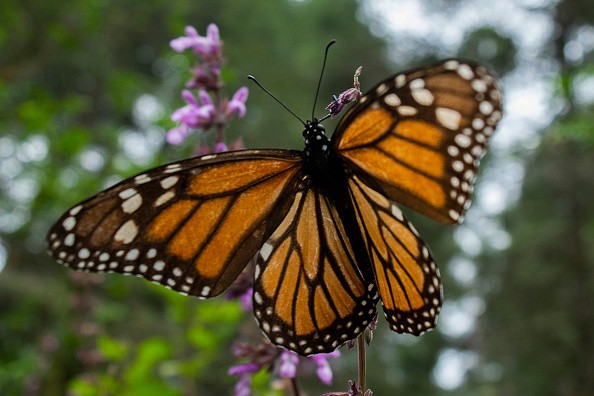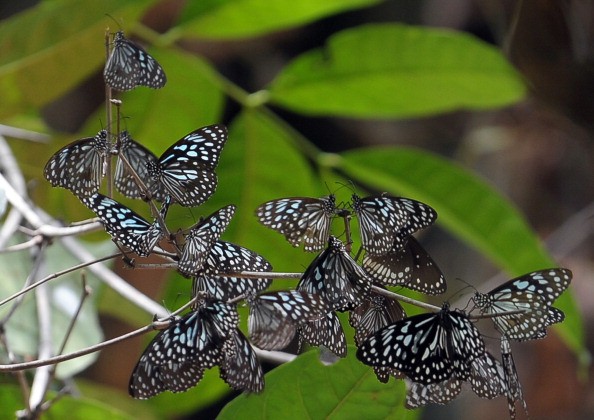Toxic milkweed plants seem to have prompted an evolutionary cascade through various layers in the food web, producing genetic changes in bugs, worms, mice, and birds.

Why Animals Survive Eating Poisonous Butterflies
Toxic cardiac glycosides generated by milkweeds (Sapotaceae) are not deadly to monarch butterflies because of their unique genetic twist that allows them to eat milkweed. To protect the butterfly from predators, these poisons are hidden in certain areas of the butterfly's body.
One of these predators, the black-headed grosbeak (Pheucticus melanocephalus), has been seen migrating to Mexico in the winter to feed on monarch butterflies, according to Science Alert.
To consume such a dangerous bug without dying has long been speculated by scientists, and now it seems that this bird has developed some of the same defense systems as its prey.
Scientists began searching for similar genetic alterations in black-headed grosbeaks after the genome of the bird was released last year.
Two of the three genetic oddities reported in the butterfly sodium pump genes were discovered in this predator in the end.
Also Read: Birds Learn to Stay Away From Flashy, Difficult-to-Catch Butterflies and their Replicas
Mutations in Pump Genes
Sodium and potassium enter and exit body's cells via pump gene, but milkweed toxins may interfere with this process, causing the organism to become unstable. Birds and humans may die from heart failure if they ingest enough of the poison.
The discovery, according to evolutionary scientist Noah Whiteman of UC Berkeley, resolves a 40-year-old mystery where the biology was well recognized but the DNA couldn't be examined to determine how grosbeaks do it.
Incredibly, it seems that they are developing resistance utilizing the same type of machinery and genetic code locations as the monarch and aphids, the bugs and beetles that also feed on milkweed.
That researchers were able to find these genetic variants in several food chains is even more remarkable. There are two mutations in the same portion of the sodium pump gene in the parasitic wasp - Trichogramma pretiosum - which attacks monarch eggs.
A nematode that grows among milkweed plants, Steinernema carpocapsae, and deer mice (Peromyscus maniculatus), both prey on monarch butterflies.
Although more genetic tests are needed to corroborate this idea, the data indicate that at least two pump gene mutations are required to enable animals to feed on monarch butterflies.

Genetic Mutations Needed to Consume Milkweed Toxins
Evolutionary systems scientist Simon 'Niels' Groen of the University of California Riverside believes it's astonishing that convergent evolution happened at the molecular level in all these species. According to Groen, toxins from plants have influenced evolution at least three layers down the food chain.
It's possible that the struggle between these predators and prey has deep evolutionary origins, given that all four of these creatures are closely related. There may be a domino effect of mutations across numerous food web levels due to plant poisons.
It is not clear whether these are the sole genetic alterations necessary for milkweed poisons to be absorbed, but more genomic research is expected to resolve that issue.
For example, the black-backed oriole (Icterus abeillei) eats up to a million monarchs each winter, yet it avoids the most harmful components of the monarchs it consumes. Unlike hummingbirds, grosbeaks devour the whole butterfly.
The orioles' genome has not yet been sequenced, but it will be fascinating to see whether they have the same genetic mutations in the pump genes or if they have developed a different mechanism.
Related Article: Population of Monarch Butterflies in California Bounces Back Following an All-time Low
For more news, updates about butterflies and similar topics don't forget to follow Nature World News!
© 2024 NatureWorldNews.com All rights reserved. Do not reproduce without permission.

![Tsunami Hazard Zones: New US Map Shows Places at Risk of Flooding and Tsunamis Amid Rising Sea Levels [NOAA]](https://1471793142.rsc.cdn77.org/data/thumbs/full/70325/280/157/50/40/tsunami-hazard-zones-new-us-map-shows-places-at-risk-of-flooding-and-tsunamis-amid-rising-sea-levels-noaa.jpg)



